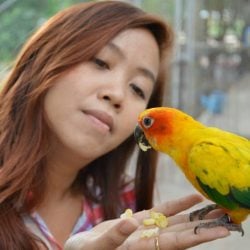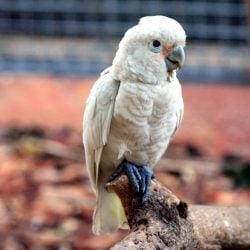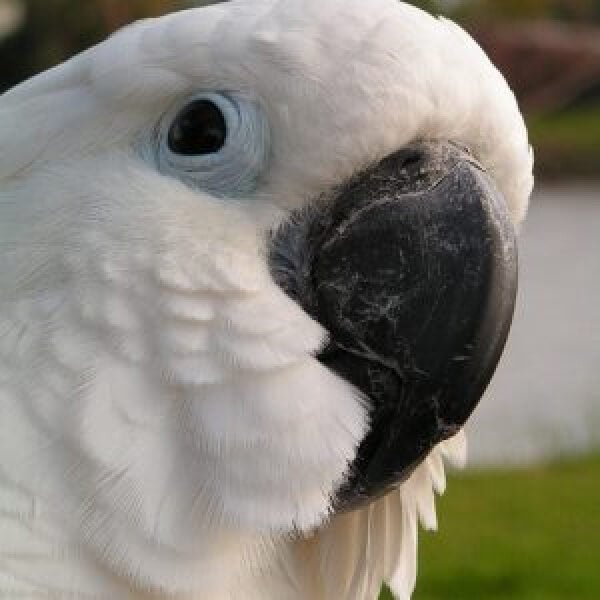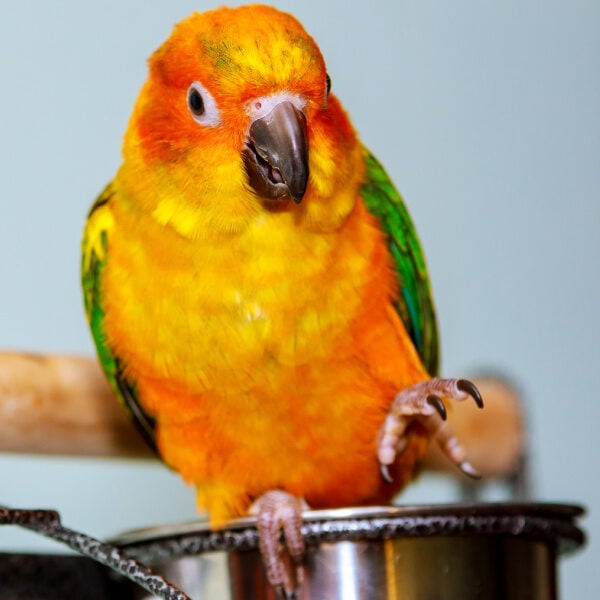Last Updated on by Mitch Rezman
A Conversation with Greg Glendell, UK Parrot Behaviorist: Part Two — Screaming
A few weeks ago we began our three part series about a telephone conversation I had with noted UK parrot behaviorist and author, Greg Glendell. Because we talked for about two hours, I found it best to break the highlights of our conversation into the three main topics: biting, screaming and plucking. Part One of the series covered biting. Today I’d like to summarize some of our discussion on parrot screaming.
First, let’s define what we are referring to as screaming. All birds make noise. They greet the day, greet their beloved humans and make noises in play. Problem screaming is the endless hours of screaming that owners often feel have no specific stimulus, the kind the neighbors
The first topic we touched on was about conure noise. Someone had said he could hear his Patagonian conure a block away and wanted to know why the bird screamed so loudly. Both Greg and I found the answer to this quite easy: the conure was being a normal conure. As a sun conure parent, I know all too well how far conure voices can carry. But a quiet conure is usually a very ill parrot. Too often people buy beautiful conures without learning about them in advance, resulting in far too many conures going from home to home in search of a loving human that understands that parrots are loud creatures. But the same applies not only to conures but all species from shrill love birds to cockatoos and macaws.
Parrots use their voices to communicate a lot of things from the simple joy of living to danger of potential danger from a real or perceived threat, to location of flock members (you) to fear or confusion. Most parrots have a noisy period in the morning, another during early afternoon and early evening. One helpful tip is to encourage talking as an alternative to screams, but not all parrots ever learn to talk while others learn hundreds or thousands of words.
I then shared an experience I’d encountered while breeding budgies and cockatiels and working at Kennedy Space Center. Everyone knew me as one of the parrot people and that I often had birds available for good homes at low prices. One of my co-workers approached me inquiring about my thoughts on getting his 10 year old daughter a tame baby budgie. I explained all the good and bad points of small bird and energetic kids. He assured me his only child was quiet and studious, not hyper at all. I said it might work well and I would let him know when my next babies hatched so he could bring his child over to learn about them and see how they interacted together.
He thought that a great plan but then said, “I just hope it won’t be noisy like cockatiels are.” I then gave him my regrets on his assured unhappiness about becoming owner of any species because ‘tiels are about the quietest species around and happy budgies twitter and sing hours daily. I suggested his considering an aquarium with a very quiet pump for his child. No disrespect was intended; not every family or person is suited for sharing life with birds or parrots.
We then discussed how smart parrots are about using screams to train their humans. Many owners go to their birds and offer treats to get them to be quiet. So, then the bird learns that if it wants a treat, just scream. The same works with wanting attention, companionship or a dramatic display for the bird’s amusement. Too often people teach their birds to scream to get a response or the bird is really training the person; sort of like the chicken or the egg dilemma.
The only proper response to screaming to earn attention or reward is to remove yourself from the situation IMMEDIATELY – turn your back with no eye contact and go into another room –returning with a reward only after the bird becomes quiet. At first only a few seconds of quiet earns the reward of attention, praise and a treat. Slowly, each time increase the quiet time necessary to earn the reward. Very soon your brilliant feathered pal will figure it out: quiet = what I want, screams = no reward. After solving the immediate screaming issue, you can also encourage the bird to learn to ask for attention or treats in other ways such as works, ringing a bell or similar less noisy means.
There’s also the problem of jealous screaming. Often a bird picks a favorite person in a family; this may or may not be the person who does most of their care and cleaning. When that favorite person spends time and gives attention to other family members, the bird may scream from jealousy. This problem can be worked on by asking the favorite person to spend less time with the bird for a while to allow the bird to realize that other family members provide great attention also. However, there has been more than one case where things reach the point of “me or the bird”. Often the solution so everyone can be happy is giving the bird a birdy friend to bond with. If you choose the same gender bird, you won’t end up with babies to home and, while the parrot may want a lot less to do with humans in general, at least everyone can live together.
UK parrot enthusiasts and Greg specifically tend to believe that allowing birds to be flighted and even permitting free flight solves many problems on screaming. I do not totally agree but this view is becoming more popular in the US. It’s a decision every parrot owner has to make for themselves. Clearly there are merits and dangers on each side of this argument.
We also discussed the problems that develop when people devote too much time to a new playful young parrot only to find themselves ignoring the bird as time passes and the parrot begins bad behavior such as screaming from boredom and lack of quality out of cage time.
Both Greg and I agree that upon choosing to share life with a companion parrot, a realistic schedule be set up and followed that devotes a fair amount of daily time to the bird, time to family, work, play and rest. Parrots love structure and knowing that they can expect their person or period to play with them in the morning and evening for periods of time as well as other times sprinkled through the day if possible. Toys are important distractions and every parrot must be taught to play alone parts of the day. Healthy interesting food with limited treats is a must every day as well as fresh clean water and the chance to choose to bathe. Changing toys frequently, providing things to chew on, shred, preen and foraging toys are all important to providing for a well-balanced, happy parrot that doesn’t scream endlessly when alone.
I do hope that some of this information that Greg and I discussed will help to learn to live a better life with your parrot. If you are experiencing screaming issues, perhaps you’ll find a tip you haven’t tried that will help you and your feathered kid be contented companions for life.
Written by the Windy City Parrot content team.
Author Profile

Latest entries
 Bird & Parrot CareJune 20, 2025Understanding the Best Way to Use Prevue Pets Mimic Me Voice Trainer
Bird & Parrot CareJune 20, 2025Understanding the Best Way to Use Prevue Pets Mimic Me Voice Trainer Bird BehaviorJune 6, 2025How Do I Keep My Parrot From Dumping His Food Every Day?
Bird BehaviorJune 6, 2025How Do I Keep My Parrot From Dumping His Food Every Day? Birds & LightingMay 16, 2025I Am Seeking Clarity About Lighting for My Birds Cage
Birds & LightingMay 16, 2025I Am Seeking Clarity About Lighting for My Birds Cage Bird RescueApril 29, 2025How Do We Re-Home a 17 yr Goffin Cockatoo?
Bird RescueApril 29, 2025How Do We Re-Home a 17 yr Goffin Cockatoo?




